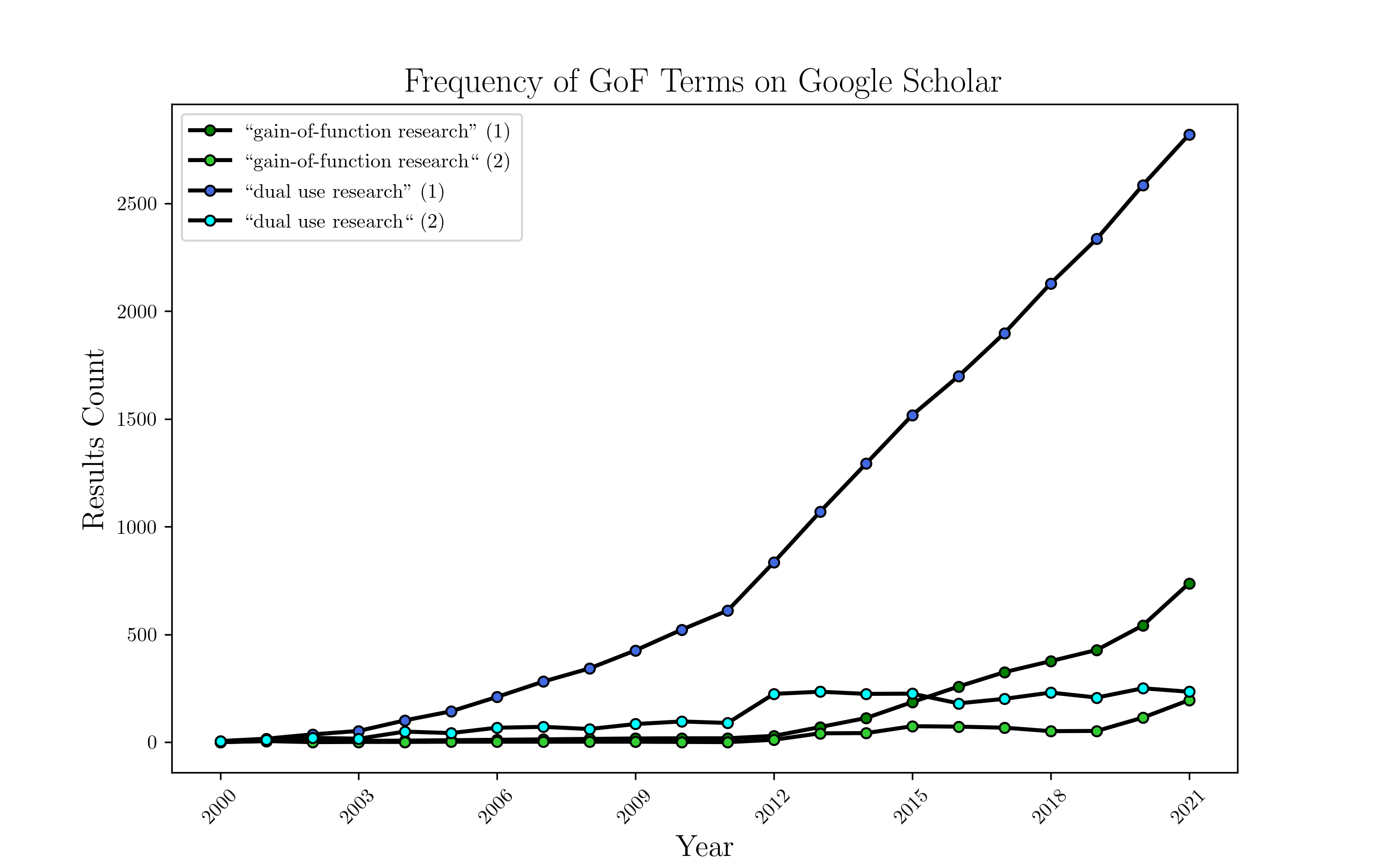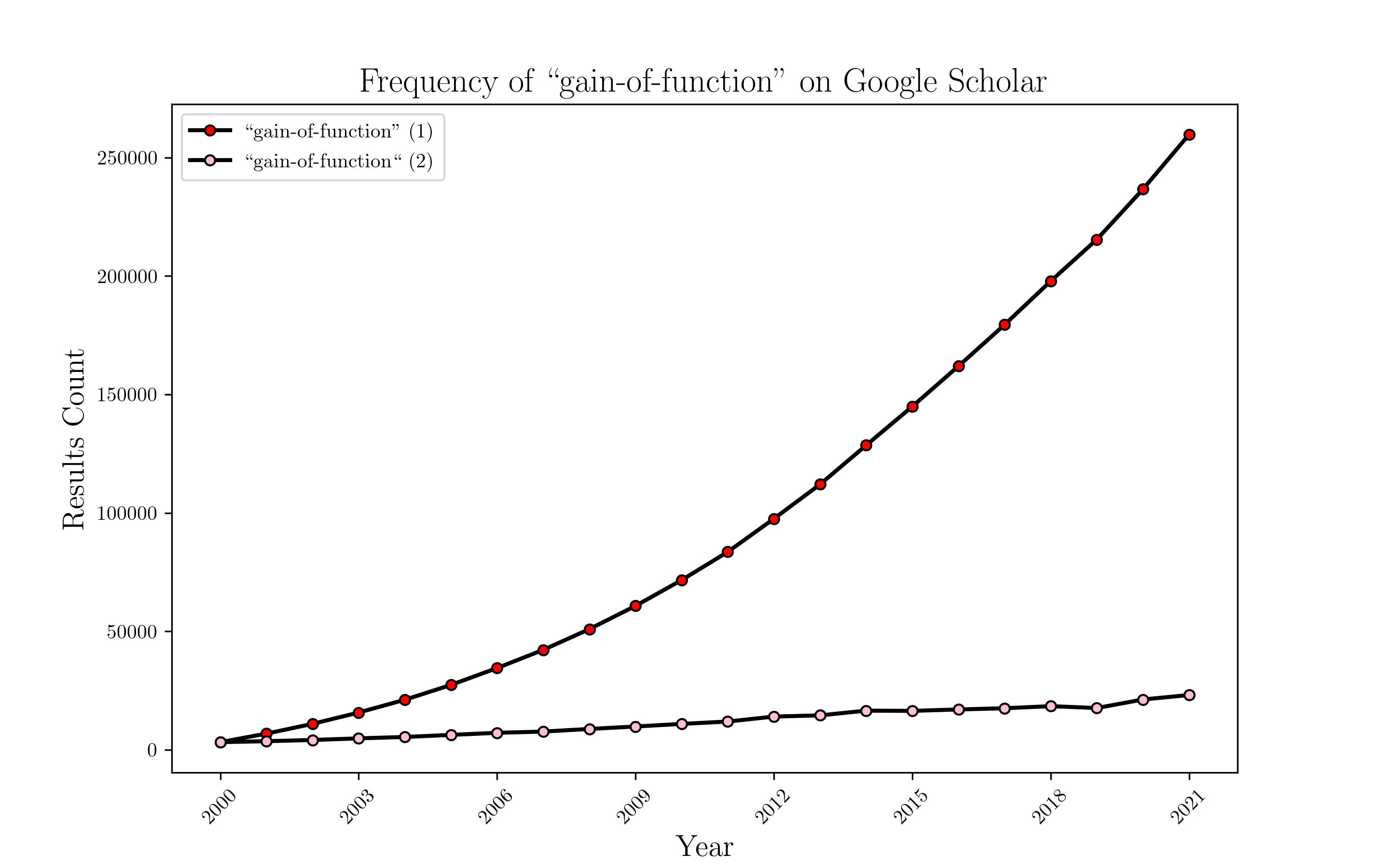How has the total amount of gain-of-function research worldwide grown/shrunk over time?
post by johnswentworth · 2022-05-19T15:57:55.414Z · LW · GW · 2 commentsThis is a question post.
Contents
Answers 11 AllAmericanBreakfast 10 AllAmericanBreakfast 8 AllAmericanBreakfast 5 rodeo_flagellum None 2 comments
Given the advance in underlying biological tools/technology, I would not find it surprising if gain-of-function research had increased 10x over the last decade. (This is just based on priors; getting an actual estimate is the point of this question.)
Why is this interesting? Assuming that both original covid and at least one strain were lab leaks, the rate of growth of gain-of-function research has a huge impact on how often we should expect future pandemics from lab leaks. If the amount of gain-of-function research has been roughly constant over the last 20 years, then the two covid leaks suggest a base rate of something like one or two pandemic-level leaks every 20 years, and covid was probably unusually hard to contain in a lab for some reason on top of that. On the other hand, if the field has grown 10x in the past 5 years, that suggests a base rate more like a leak every 2-3 years (and probably getting faster over time as the field continues to grow). If that's the case, then the base rate for pandemics will be way higher going forward than in the past.
Answers
In general, it seems like GOF research doesn't have a crisp definition or a transparent reporting process. If it were possible to come up with criteria for evaluating whether or not a particular publication constituted GOF research and to easily identify studies that met those criteria, it would be possible to look at whether publication of such research has been increasing over the last 5 years, and use that as a proxy for the amount of research being done. But I don't think that's currently possible.
The NSABB is chaired by Samuel Stanley, who quoted in 2017 "I believe nature is the ultimate bioterrorist and we need to do all we can to stay one step ahead.” So it seems like NSABB is likely to remain an opaque institution, being run as a sort of security theater to justify continued GOF research while avoiding scrutiny.
"We saw in Chapter 7 the estimates of the rate of a laboratory acquired infection (LAI) range from 0.000057 to 0.001 per person per year, and the risk of onward transmission ranges from 0.05 to 0.15. If assume that 200 people are working on gain of function experiments in virology involving PPPs, and we place the risk of LAI rate conservatively at 0.0001 per person per year, then this would yield a risk of an LAI of 0.02, or one LAI every fifty years. If we assume the rate of onward transmission of a LAI is 0.15, then this would give us an annual risk a LAI leading to community infection of 0.003, or about one event every three hundred years.
Of course, this estimate of the risk depends on several assumptions we have made, and different people might arrive at different estimates. A great deal depends on how many people are working on this research and their adherence to biosafety protocols. Fouchier, one of the principal investigators who conducted to controversial H5N1 experiments, has estimated the risk of a LAI from this type of work to be 1 LAI per 70,000 persons per year or 0.000014 (0.0014%) per person per year (Fouchier 2015). Fouchier’s risk estimate was based on LAI data for people working in BSL 3 labs. Fouchier estimated the risk of onward transmission of a LAI to be between 0.00000025 and 0.00003 for a probability of onward transmission from a LAI related to this type of work of 1 person per 33 billion years (Fouchier 2015). Other researchers have calculated the risk of onward transmission to be much greater than Fouchier’s estimate. Klotz and Sylvester (2012) estimate the risk of onward transmission of a LAI from gain of function experiments in virology to be 0.003 per laboratory per year or once per 536 years. However, they also factor in the number of labs that may be conducting this research (42) for an estimate of one event every 12.8 years. Lipsitch and Bloom (2012) and Lipsitch and Galvani (2014) also consider the risk of onward transmission of a LAI from this type of research to be much higher than Fouchier’s estimate."
The NSABB reviews GOF research in the USA, but:
"A committee at the Department of Health and Human Services is now tasked with making final decisions about what is and is not a gain of function experiment. But longtime critics of federal oversight still aren't pleased. Ebright claims that apart from two projects carried over from prior to 2017 — the Fouchier and Kawaoka research on H5N1 — there are no public records of any reviews being performed, suggesting that "the NIH doesn't flag projects for review, nullifying the policy.
Arturo Casadevall, a microbiologist at the Johns Hopkins Bloomberg School of Public Health, co-authored a 2020 editorial in the journal mBIO, reporting that both PC30 reviews to date have been made behind closed doors, despite guidance from the White House at the time the framework was released encouraging a transparent process."
While I have not tried to measure whether search term frequency is closely correlated with the amount of interest or activity in a field of research, I often find it useful, and believe that the search term growth rate likely corresponds somewhat to change in funding and/or research activity and its offshoots.
Below, I have searched three terms (with quotes) on Google Scholar, not including citations, for years in the close interval [2000, 2021]. Note that (1) corresponds to cumulative results, and (2) corresponds to results for that particular year.


I am unsure how to resolve the massive differences between the number of search results for "gain-of-function" and "gain-of-function research". From skimming the articles that appeared after each search, one explanation might be that there is indeed a lot of gain-of-function research that only uses the term gain-of-function (e.g., "gain-of-function mutation"). I still don't suspect the overwhelming majority of the results from searching "gain-of-function" actually refer to gain-of-function research, but the evidence that many of the results are What We Want leads me to believe that this graph is probably useful for looking at the growth in the field.
↑ comment by DirectedEvolution (AllAmericanBreakfast) · 2022-05-20T16:57:44.323Z · LW(p) · GW(p)
One challenge here is that GOF research is a charged ethical issue, and if you look at the papers, a lot of them are on the ethical concerns. Another chunk is looking at gain of function mutations in cancer, which is irrelevant. Researchers engineering gain of function mutations in pathogens don’t necessarily put that language in the title or abstract. For example, the infamous avian flu GOF research by Fouchier in ferrets didn’t use the term “gain of function” in the title or abstract.
There’s a baseline growth rate for research generally, and output doubles about every 17 years. Given the charged nature of GOF research and the recent moratorium, I’d expect its publication pattern to diverge from the general rate. And since it’s a small field, I’d also expect that noise from irrelevant findings to swamp any signal from the kind of potential pandemic enhancing research we are worried about.
2 comments
Comments sorted by top scores.
comment by tailcalled · 2022-05-19T16:52:04.782Z · LW(p) · GW(p)
I'd hope if we start getting a leak every 2-3 years, we'd make world-wide laws to shut down GoF research.
comment by Richard_Kennaway · 2022-05-19T17:07:48.180Z · LW(p) · GW(p)
Perhaps there should be an independent organisation, if there isn't one already, to keep track of high-risk biological research and watch all the high-containment facilities worldwide.